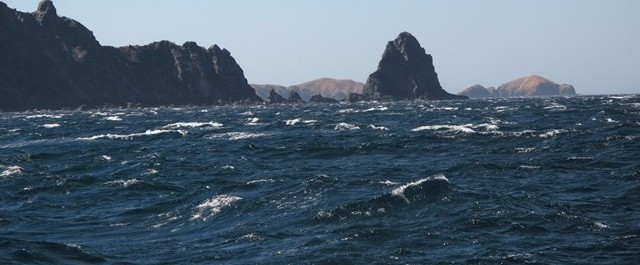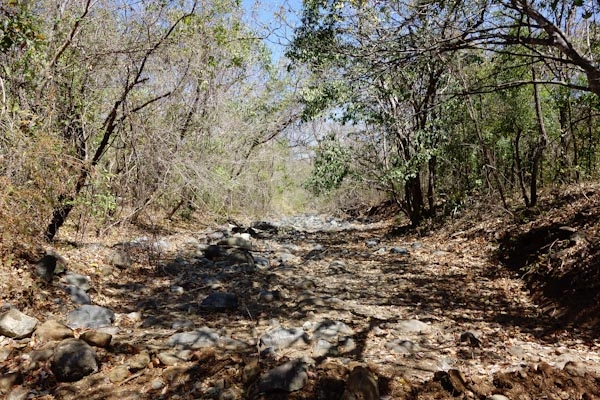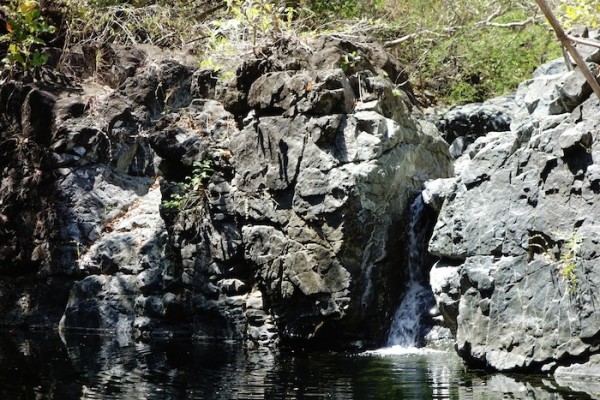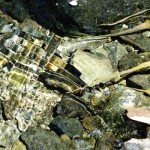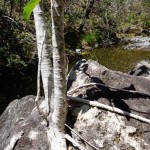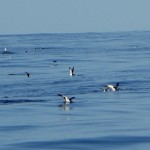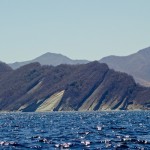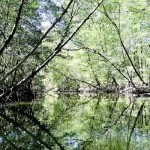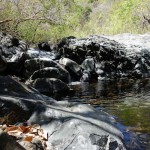We did a fair bit of motoring in south and central Costa Rica because there was just no wind. Then we got to the north end of the country where, at this time of the year, they often have too much wind. The Papagayos, as they’re called, arrive from the northeast thru gaps in the mountains of the isthmus downstream from the western Caribbean, which gets them from the frontal systems that bring eastern North America their winter storms. See, it really is all connected!
 So there we were in the snug shelter of Bahia Santa Elena, a national park, all checked out of Costa Rica and on our way to Nicaragua when the proverbial weather window opened. But wait, a hike to a waterfall with some new friends? The answer is always yes. In this case, the land looks pretty dry and it was puzzling that there could even be enough water for a bathtub in the dry stream bed that is the start of the path to the waterfall.
So there we were in the snug shelter of Bahia Santa Elena, a national park, all checked out of Costa Rica and on our way to Nicaragua when the proverbial weather window opened. But wait, a hike to a waterfall with some new friends? The answer is always yes. In this case, the land looks pretty dry and it was puzzling that there could even be enough water for a bathtub in the dry stream bed that is the start of the path to the waterfall.
But the water gradually filled in, and at the end, eureka, a modest water feature in a refreshing little pool.
Our friends were going south, we were going north, and the Papagayos were supposed to start building the next day, but when? One of us was going to have a nice day.
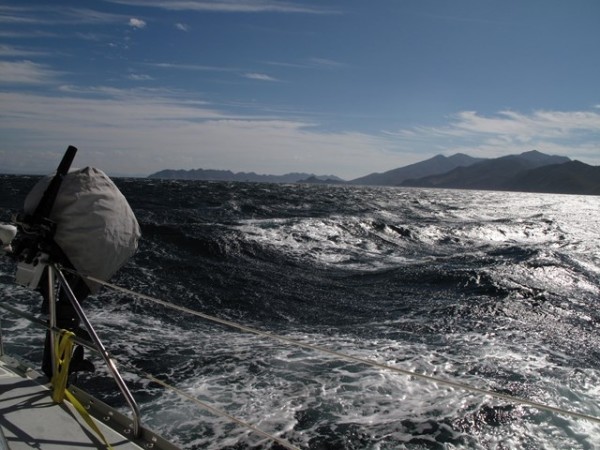 This photo, courtesy of Pat on Always and Forever, is what our friends got; they ended up blowing downwind in 30-plus knots with no sails up at all. Our end of the stick was a little messier, because we were going where the wind and seas were coming from. Doug steered up into every lull, but it soon became apparent that we would be unable to lay Bahia San Juan del Sur, Nicaragua, our intended destination. Luckily, 7 or 8 miles further on, there was another bay, Pie de Gigante (Foot of the Giant), which we did manage to get close enough to to enter, and with a gigantic sigh of relief we stayed put until conditions moderated a day and a half later.
This photo, courtesy of Pat on Always and Forever, is what our friends got; they ended up blowing downwind in 30-plus knots with no sails up at all. Our end of the stick was a little messier, because we were going where the wind and seas were coming from. Doug steered up into every lull, but it soon became apparent that we would be unable to lay Bahia San Juan del Sur, Nicaragua, our intended destination. Luckily, 7 or 8 miles further on, there was another bay, Pie de Gigante (Foot of the Giant), which we did manage to get close enough to to enter, and with a gigantic sigh of relief we stayed put until conditions moderated a day and a half later.
That gave us time to investigate small losses in the engine’s fresh water cooling system. Eventually, rather than take the chance of doing damage, we decided to head straight for Mexico without dawdling in Nicaragua, El Salvador or Guatemala, and without using the motor. Thus began a trip that could theoretically be done by us on four good days, but took us more than twice that time, especially after we left the Papagayo wind zone.
It is easy to think of hours spent becalmed, rendered motionless by lack of wind, as hours wasted. In my opinion, the hours I wasted were the ones trying to make the boat move on zephyrs. You get to think a lot about the mariners of yore trying to make their way through these waters in heavier and more awkward vessels, without a stack of books to read. Too hot to cook, and we’re at the bottom of the propane tank anyhow. The fridge is turned off, and reveals itself to be the consumer of two-thirds of the power we use each day. Ships pass by on their way to Puerto Quetzal, or Acajutla or Corinto; the AIS tells us even when they’re too far off to see. Tick, tick, tick.
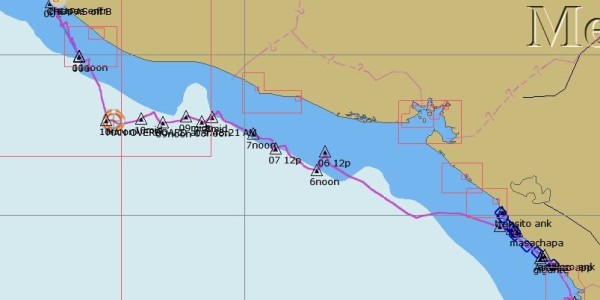
The glassy seas reveal more turtles than I’ve ever seen in a patch of ocean. Some of them had sea birds sitting on their backs. There was a wealth of dolphins, and, always at a distance, leaping dorados. No trash on this stretch of sea, thank goodness. Seabirds look us over, and some start to land and settle in.
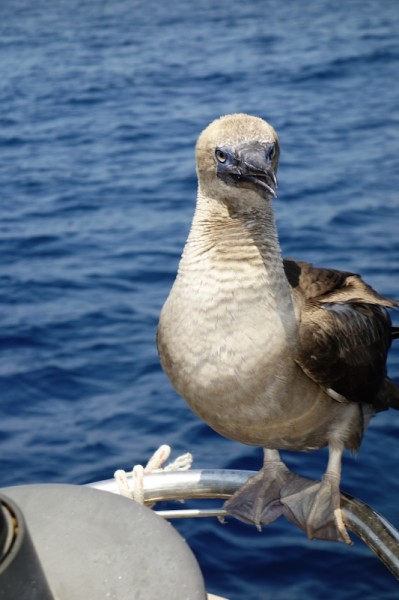
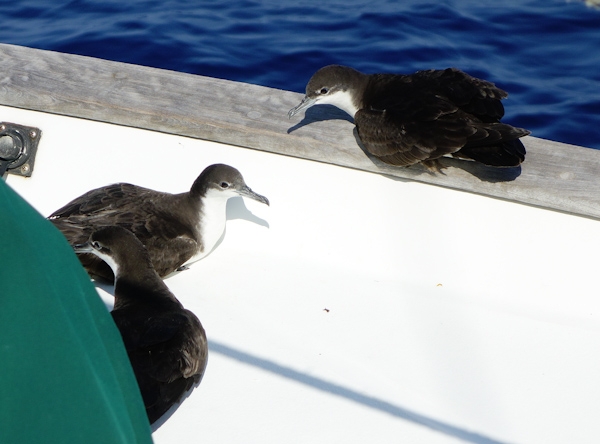
Just so you don’t visualize all torpor and sloth, there were several adrenalin-filled spells as well. The most prosaic was the squall, at 4am, under a dark cloud that first paralyzed us by stealing our wind, and then, like a spider waiting for the poison to take effect, pounced to shake us up. With heat lightning bright enough to read by in the clouds, but enough forks coming straight down to keep us sitting bolt upright below, not touching anything metal, it was a long half hour. Good thing we had plenty of sea room, being 40 miles offshore.
At least we thought we were alone. But the next night there was a little twinkle of light on the horizon, and then a minute later another, maybe not so imaginary after all, and maybe not so far away either. Peering into the dim as we ghosted along, we decided that the tiny flickers marked fishermen sound asleep or, more likely, their apparatus. It was nerve-wracking trying to steer around something we could only see once a minute, and a great relief at daybreak to not see anything at all.
Then, up from nowhere zoomed a lancha, come to inform us of their floating polypropylene line (holding up a sample!) in the water in front of us, and to show us which way we could go to get around it. In the next couple miles, 44 miles from shore, there were three more ‘fields’ of isolated floats and poles, not one with a light, and that’s the last we saw of fishing, that we knew of.
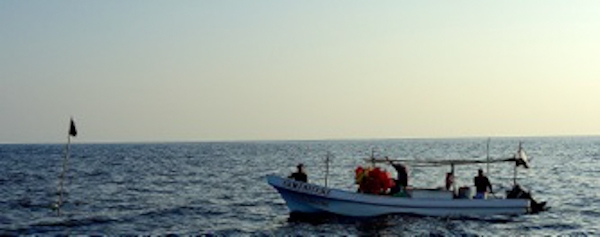
The third excitement was the visit from the whale. It’s a real thrill to see something so big and ‘charismatic’, to see the blow and watch the power of its movement. But, it’s close to frightening when all of that is nearly as big as we are, and a mere sixty feet away. I felt like this was a young and curious whale. I say young because its skin was clean and dark, not like the barnacled ones I’ve seen in photos, and curious because it circled us a couple times at close range and dove under the bow like a dolphin, before it lost interest and vanished. I tried to take a video, but this was not the time for learning how. Better to sit and absorb the ‘whale-ness’ of the moment, then to breathe a sigh, regret mixed with relief , when it was over.
And another sigh of relief as we ‘becalmed’ ourselves to a marina dock in Puerto Chiapas, Mexico. Our cooling problem was not a blown head gasket, or anything drastic, just a leaking o-ring and a loose fitting. And of course, we’re both better people for facing the wind, both kinds, unmediated by the convenience of ‘el motor’.

